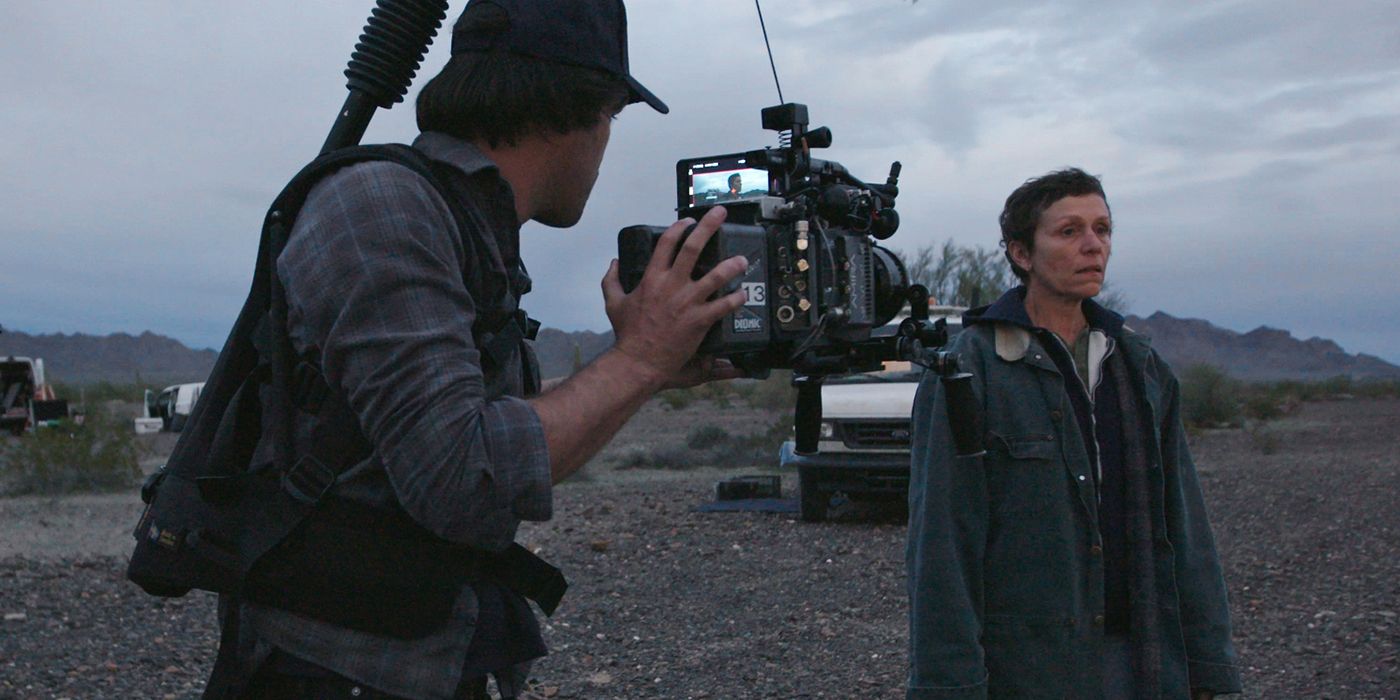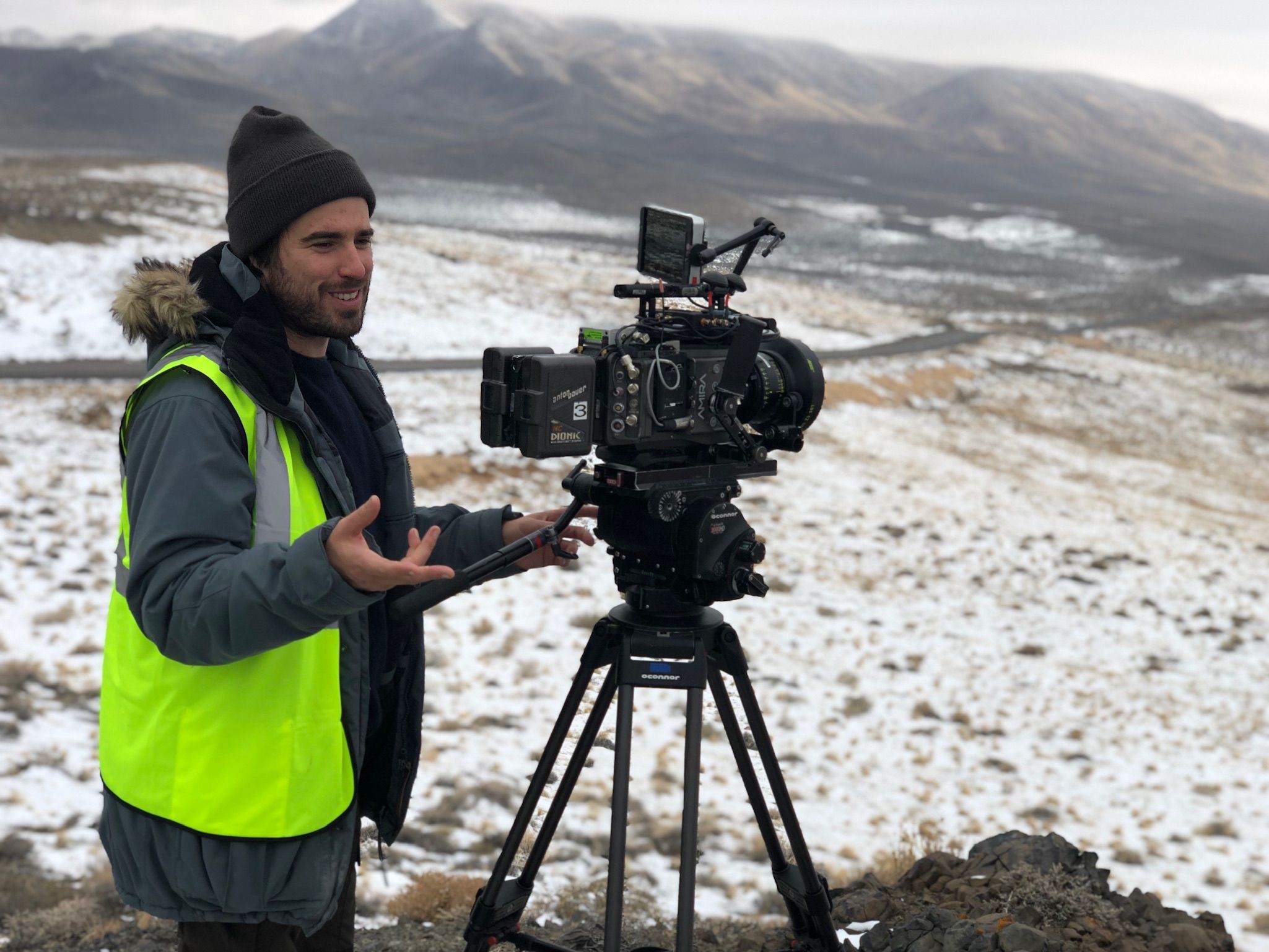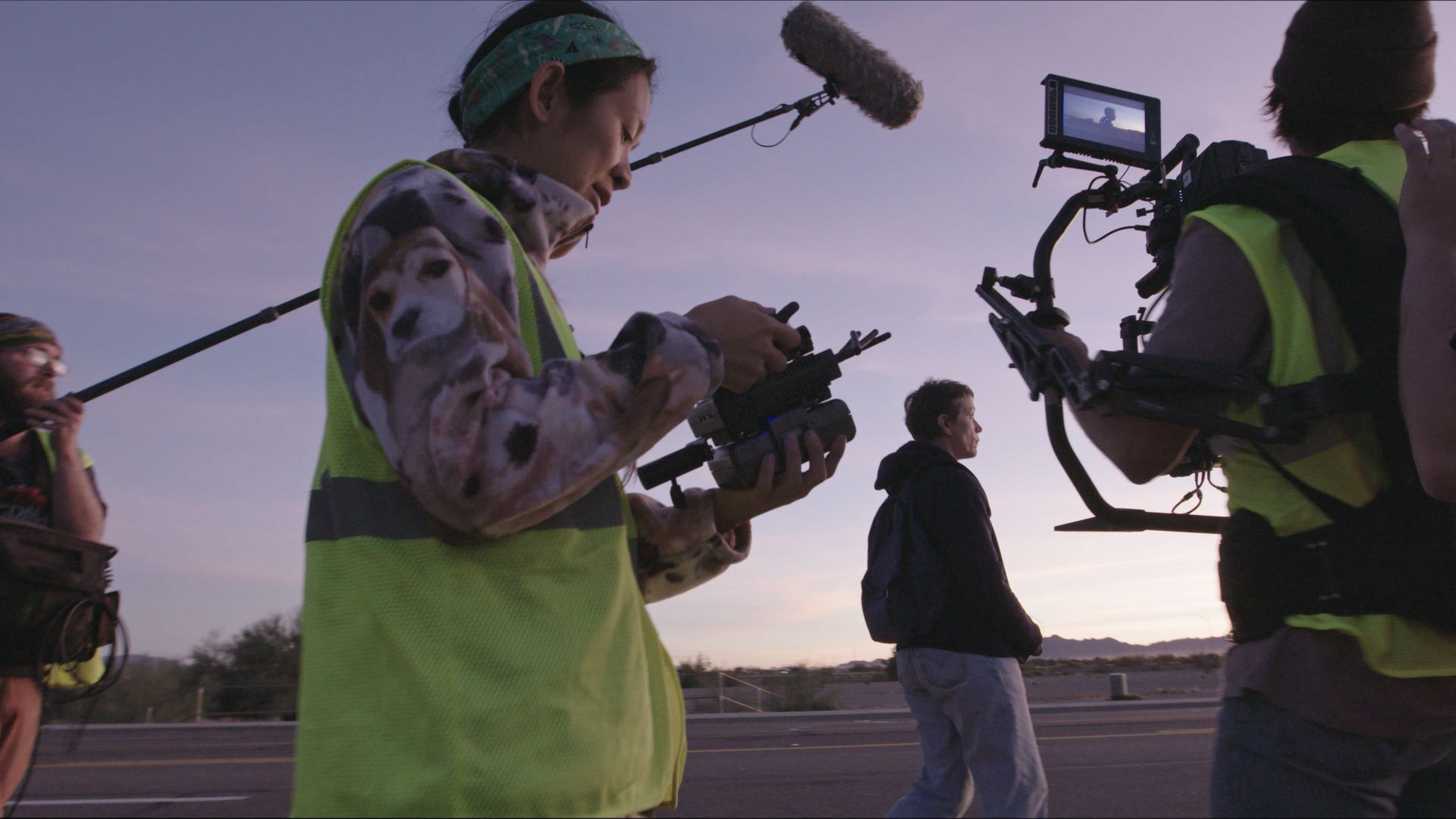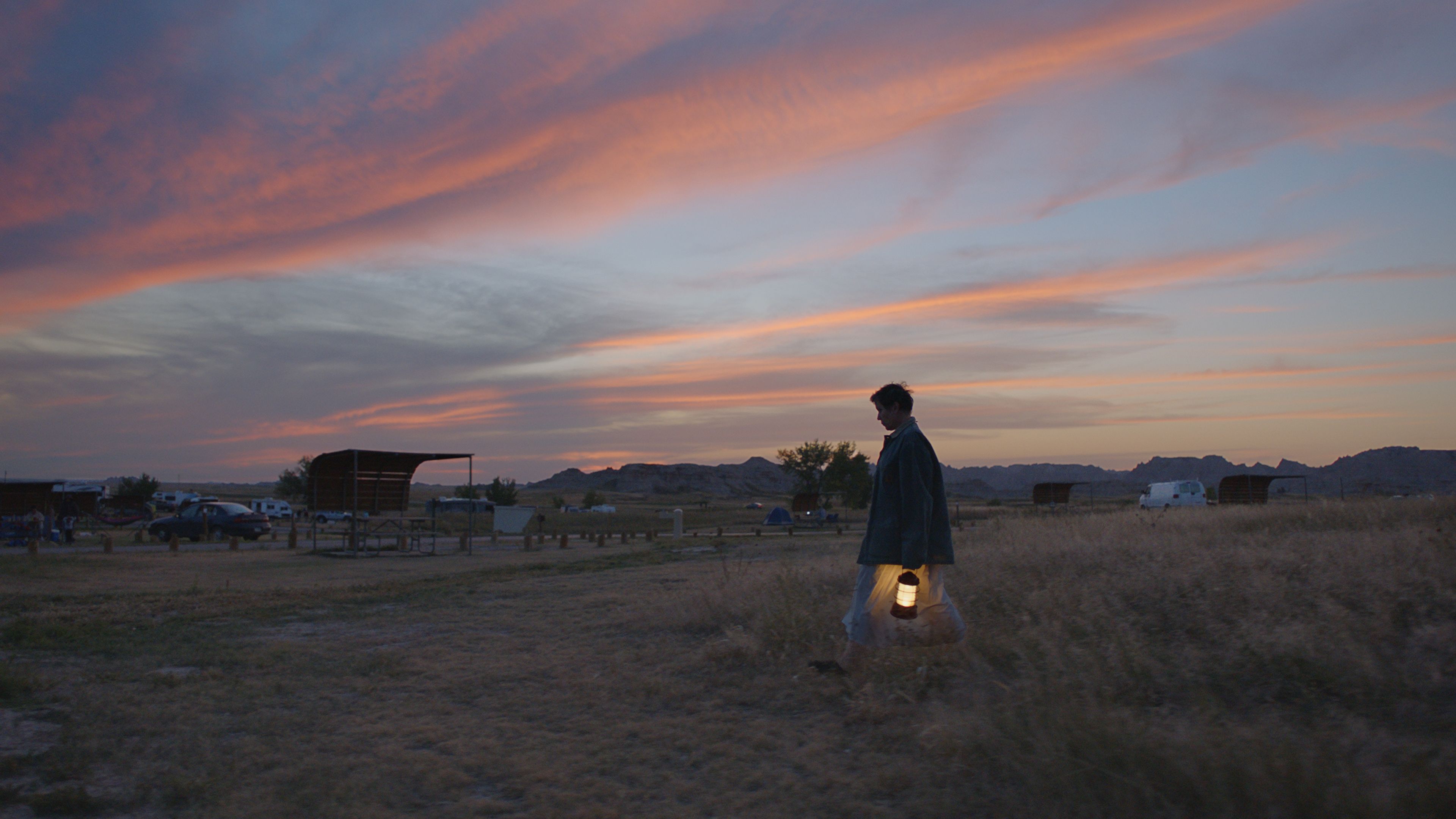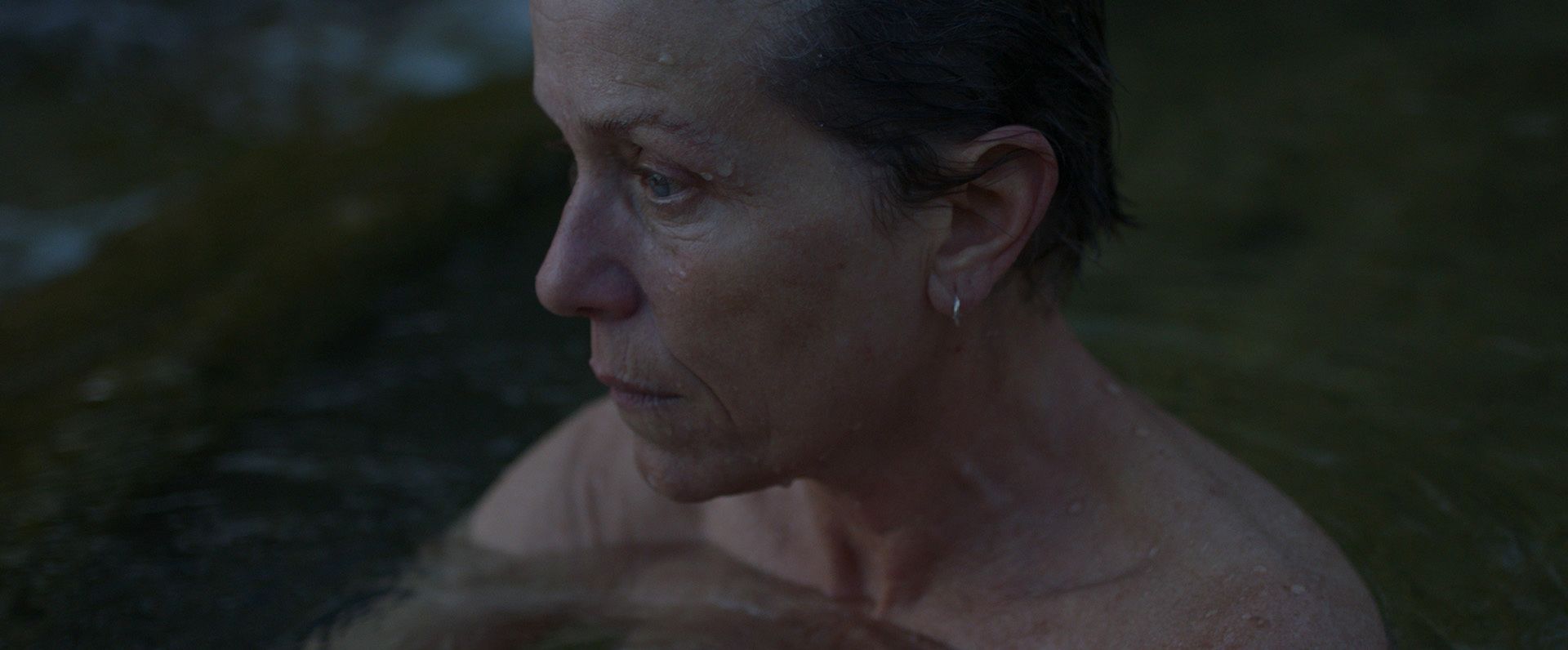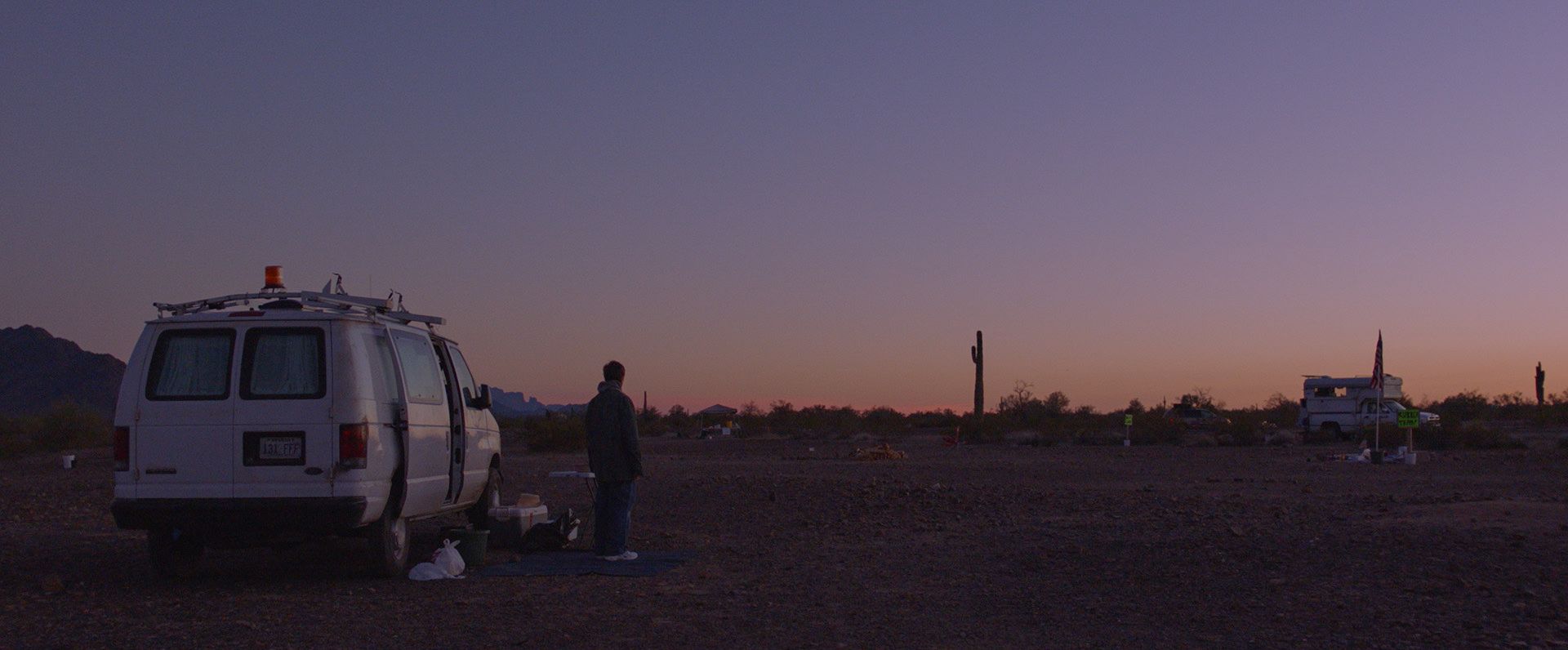Is there one right way to make a movie? Surely not. The approach to Singin’ in the Rain was entirely different from the approach to The 400 Blows which was entirely different from the approach to Taxi Driver, but that doesn’t make any of these films any less brilliant or influential. But after 100 years of making movies, cinematographer Joshua James Richards feels some of Hollywood has gotten complacent, and is keen on shaking things up for the better.
Richards’ latest film is director Chloe Zhao’s brilliant and moving drama Nomadland, which stars Frances McDormand as a woman who sells most of what she owns and decides to live on the road. It’s an intimate, character-driven story about empathy and grief, but also about the freedom of letting go and the warmth of finding a community to which you feel connected. Zhao and Richards’ visual approach on the film carries on an aesthetic they established with their 2017 film The Rider – the movie is bathed in natural light and lingers on faces and bodies, emphasizing the humanity of the people at the story’s center. It’s gorgeous to be sure, but gorgeous with purpose – Richards’ naturalistic photography emphasizes the beauty of the American landscape, but also the beauty of the people who populate it.
I recently got the chance to speak with Richards about his work on the film, and he talked about his relationship with Zhao and how their approach to Nomadland differed from their approach to The Rider. He also talked about working with non-professional actors, and using the camera to emphasize telling the story from the point of view from McDormand’s character. Richards also passionately spoke about pushing back against the industry’s obsession with cosmetic “beauty,” and how in Nomadland there was a respect for the people just as much as there was a respect for landscape.
Richards also spoke about attempting to get people to think differently about the way movies are made, specifically with regards to how he believes bigger crews don’t necessarily reflect in better-looking movies. And to that end, with Richards serving as a camera operator on Zhao’s highly anticipated Marvel film Eternals, we talked about about how he and cinematographer Ben Davis maintained Zhao’s signature aesthetic on a big Marvel movie while using a lot of natural light.
It’s a wide-ranging conversation during which it’s clear that Richards is not only passionate about filmmaking and cinematography, but about questioning convention when it feels like convention isn’t adding anything substantial to the film at hand. It also provides some fascinating insight into how one of the year’s best films was made.
Check out the full interview below. Nomadland will be released on Hulu and in select theaters and drive-ins on February 19th.
I'm curious when you first met Chloe, what was your working relationship like then and how has it evolved over the course of working together?
JOSHUA JAMES RICHARDS: Yeah, well we first met at NYU, and our first film together was Songs My Brothers Taught Me. And looking back, I think we suffered from what a lot of first-time filmmakers do starting out. You kind of create your own chaos I think, there's a lot of anxiety and defensiveness about your ideas. I think Chloe and I have, as the films have gone on, you gain confidence and a shorthand and a language that you see works. And so you kind of just start building that together, and there's so many benefits from these collaborations, because it really does become an unspoken shorthand. And what's great about that is it kind of allows for mistakes and other things to creep in, because you know you have a very solid shorthand and approach. So it’s a little like music or jazz, we know the chord progression, and that allows... Every now and again someone can go off and do a little solo or a riff.
Specifically as it relates to Nomadland, I mean I know you guys worked together on The Rider. But what were the early conversations about Nomadland? Was there anything different from your approach here that you wanted to tackle, that you kind of learned on The Rider or other things you wanted to try out this time?
RICHARDS: Yes. The biggest thing with Nomadland was the sort of shifting landscape. The film is about identity, but kind of identity connected to a specific place. A Lakota boy who's struggling with whether he stays home or leaves for college, a young cowboy who wonders who he is if he can't do the thing he was born to do, and suddenly that landscape becomes a prison. Whereas in Nomadland, the earliest discussions were about, "How do we move an audience through this landscape that's constantly shifting and changing? How do we anchor them in this film, how do we come up with the language that punctuates these moments, and you can track them geographically very clearly but also emotionally very clearly?" And that's how we were using the landscape.
So I read a piece about Chloe and how she kind of operated on this film, where a team would meet the non-professional actors the night before, and she would kind of tailor the script towards a little bit of what came of that. But I'm curious about very specifically what the workflow was like for you. Because you're trying to make something that's cinematic and looks real, but also opening up to the possibility of spontaneity and other things that might happen with these non-professional actors.
RICHARDS: Yeah. I mean, I think from what I've learned, I just think prep is the key for me. But the workflow for me, mate, was committing to this project for as long as they would let me. I really wanted to... I just thought, "If I never make another film, so be it. But this is the film." I was just in, dude. I told my agents, "No commercials, nothing." And I just looked for months, I was looking for photographers and traveling with Chloe together, meeting the nomads was a big part of the prep. I know it doesn't sound like a cinematographer's workflow, but in this particular case it truly was. I wanted a relationship with the nomads, firstly. But I had to have one to make this way of shooting possible.
It's all about getting the camera into the place of intimacy that is not forced, but real. In a way it's weird, it's like a camera that's kind of listening, and there's a connection between the camera and the subject. And that, I just think that comes about because the operator actually truly cares about the subject.
One of the greatest powers of the film to me, is it opens this access to empathy for every single person that's onscreen, and that's obviously a lot of Chloe's work. But also you, you as the camera operator, you are that window through which the audience comes to empathize and understand the struggles that all these people are going through. Obviously the dialogue does that as well, but you're doing a lot with your camera.
RICHARDS: Yeah, and the lighting — that’s completely the philosophy of the lighting, really, if you think about it. I mean, imagine me going in there and being like, "Yeah, yeah, that's great about the Swallow, Swanky. But do you mind if we just put some makeup on you?" I mean, who would I be? I just went on a rant about this before, but I want to say it again because it's [important]. In America, mate, the cosmetic industry is the biggest industry. So we, as filmmakers, all of us in media putting images into the world have a decision to make, don't we? Do you want to present people as they look, or an impossible version of how they look so that some young girl growing up looks at those images and realizes she can never look like that? Or people are so scared of growing old that we're fucking mutilating our faces. So when I see Frances McDormand and Swanky... I mean, just as a cinematographer, it's been one of the joys of my life filming their faces, because faces only get more interesting with time, mate. We just poisoned our mentality so much, and we're so scared of death that we'll do anything we can to pretend that it's not real. Whereas this film is about embracing death, and it is about embracing endings, to how we end, you know? And with respect to our place in this world, this planet and this landscape that we find ourselves in. If God exists in a Malick movie, Paganism exists in a Chloe Zhao movie.
I love that.
RICHARDS: Truly. And I identify with that. On this shoot there was a respect for landscape as much as there was people. Sometimes these big films now, we come barreling through these places and we leave a scar. And that was never going to happen on a Chloe Zhao movie. The lighting in regard to empathy, but also truth and honesty, and also listening and accepting people as they are, and capturing that instead of trying to impose our cinematic, cosmetic, nicety, prettifying things for absolutely no reason other than it makes money, was never going to find its way into this film. And it probably won't find its way into anything I shoot. And also, I'm more excited about the technology with cameras and sensors that's going on right now, and the fact that these are becoming ergonomically easier to use and smaller.
I cannot wait until my nephew can pick up a camera, he's nine, and it has the same sensor on it that I'm using to shoot whatever, and he's able to capture those images and understand them and how to use that tool, and it's just available to him. And that's what ARRI are doing. And when you rate a camera like we did on Nomadland at 1280, that's like fucking night vision, dude. You're bringing shadows in. And so, here's the thing, that takes less crew, which is great for Chloe and I, the way we want to make films, but not necessarily great for the Hollywood industry, if our crews are getting smaller and smaller. But I care a bit more about the storytelling getting better and better, and visually more exciting.
Well in some ways you're removing more of the artifice, to bring more of the naturalistic beauty out. And that's what I think is so ironic about this film, is it is beautiful and it's haunting in its beauty by stripping all that away. It feels kind of naturalistic and it doesn't feel overly stylized, but it is cinematic. And I was wondering how you kind of toe that line between, you're not making a documentary, you're not even doing necessarily a docudrama, but it feels naturalistic.
RICHARDS: Yeah. I mean, this word, cinematic, it's like, what is that? Hitchcock does a much better job than I ever could in Hitchcock/Truffaut, that great book. Much of that book is just discussing what is this thing, cinematic? Why do I have to look at this? Why is Rear Window so cinematic? Because that can't be a play, can't be a book, or wouldn't be as good. The whole point is it's about looking, about seeing. That's really what cinematic means to me. It's like, you could turn the dialogue off in Nomadland, and hopefully you'll still understand it and you'll still feel something. So you're telling stories with images ultimately, but I'll spend the rest of my career exploring what cinematic means.
I'm curious about your relationship with Frances as well, because this story is told from her point of view, and the camera, again, is this eye towards her point of view. And so there must have been some kind of symbiotic relationship between her and the camera and how you guys were operating there.
RICHARDS: Yeah, and that was a first for me, and a delight to have an actor that knows... It's not about her finding her angles, it was learning from her as a storyteller. Again, it's not cosmetic with Fran, she's cutting her own hair, no makeup team on the horizon, and I worked quite closely with her and Chloe with the costume as well, and also in the building of Vanguard from a production design point of view. Just to start with that, Fran had lots to say, because Vanguard truly is a character in the film, I mean it really is. And she helped us build that, it was her idea for example to bring in her father's plates, little props like that. But yeah, and it was incredibly intimate in there with Fran and I, you know? A critic she likes to quote once described her face as a national park, and it's very true, I can attest to that.
And I feel like I got to know that part very well, and there's a complexity to Fran's face, there's a complexity to her as a person and her performances that, since I saw Fargo as a kid, I identified her as one of the giants of cinematic acting. And also, I just think she brings a humor and a relatability to characters that you just rarely see.
We came up with her look based on a Carl Dreyer film, Joan of Arc, which also influenced the close-ups and the way we shot the film. If you want to talk about empathy, I mean that film, that's it. If I had to describe to someone what empathy is, I'd probably show them Joan of Arc. And we talked about Buster Keaton as well, and Charlie Chaplin. I think, like that scene where she's wandering in the badlands — I kind of fell in love with Fran's body language as well. And so these wider shots of her walking, I was constantly wanting to pull back from Fran sometimes as well, because of just her physical acting. And yes, it really felt at times like she was channeling something of... I mean, that sequence, man, in the badlands when she's lost, dude, it's not easy to do that as an actor. "Go, look lost." And to do it to hit these beats, and I would just kind of be reacting to her, really. I would generally tell her, "Look, I've got to be looking that way, Fran, because obviously the light and stuff. But go for it, I'll adjust, don't worry." And that was where the Ronin 2 really came in handy, it was about adjusting to what was happening rather than giving people very specific marks and things to hit. We really needed to allow freedom to be felt all the time.
So does Chloe storyboard all?
RICHARDS: Yeah, on our first films we might have drawn more diagrams. Diagrams mostly, like sort of overhead aerial diagram. But then I think by the time it came to Nomadland, there's such a trust between us, and you've really lived the film for months before you get to set, so there's a silent understanding. But then also Chloe will come and have really specific frames in mind sometimes, and I'll have no problem with her putting a hand on the camera, doing that. But then also, she storyboarded on Marvel’s Eternals, that's for sure. She does beautiful storyboards. But no, I adhere to Werner Herzog, "Storyboarding's for cowards."
Well, you mentioned Marvel. I'm curious, I know you were a camera operator on Eternals. When you show up on set, and hundreds of millions of dollars have been put in, and you've got costumes everywhere, and huge production design. I'm curious what your collaboration specifically was with Ben Davis as the cinematographer on that, what it was like for you to kind of... I don't know if step back is the right word, but be the camera operator, but still making sure that it feels like a Chloe Zhao film.
RICHARDS: Yeah. I think you've answered it right there, mate. It was, Ben was aware of our collaboration, and I was aware that I don't have the experience to navigate that vessel actually. I was the first to hold my hands up and say that, and I really wanted Chloe to have as much experience and support behind the camera as possible. I think as their collaboration wore on, they kind of felt, "Well look, hey, how about we bring an operator in that you're just completely comfortable with, understands you, understands your language…” And really, that's me. I was happy to dive in and learn from Ben, and see what it looks like to navigate a vessel that big.
From your perspective, does it feel in-step with Nomadland and The Rider?
RICHARDS: Yeah. I mean, Ben Davis put it best, him and I think his gaffer were having a chat and they were like, "Oh, don't you miss the days when we could make films with 25 people?" And Ben said, "Well, we still do in a way. The 25 heads of department is the same, so the inner core is kind of the same. It's just they've all got 10 assistants, or a bigger crew working underneath them." But do you know what I mean? In terms of the decision-making, and actual essence of filmmaking, the language is the same. So it's just the tools get bigger, and so therefore the manpower multiplies drastically, yeah.
I interviewed Rachel Morrison when she was doing some reshoots on Black Panther. And she said the biggest challenge for her was maintaining depth of field and consistency of lighting, because you're shooting one scene that's supposed to take place over three minutes, but you're shooting it over two weeks outdoors, and you're dealing with different cloud cover and everything like that. Was that one of the big challenges for you guys?
RICHARDS: I can see what you mean. Yeah, do you know what mate? I will say, none of what Rachel Morrison says applies in any way to Chloe's film, that's what I can say. Meaning, if Chloe Zhao wants to shoot in actual light then she will, and there's a scene in Eternals that was shot in exactly the same way we shot Nomadland. Completely natural light, a bit of balance, five actors all running around, a race against the sun in exactly the same way we did Nomadland. And I think that's awesome, and I think we need to... Chloe and I are all about rethinking or thinking about how we want to make the films. I think this is a much more important and interesting conversation, it's very rarely had and it's about how we make films. It doesn't come up, because once you find a template that makes money, why would you change it?
Well, you can prove me wrong because they've been doing it for ages and it makes loads of money. My argument is, "Yeah, but the art form's still stuck in the birth canal, and then so this so-called professionalism you talk about is an illusion." It's like, my background's in painting. Imagine me walking around saying “I'm a professional painter.” You would know I'm not a very good painter if I was telling you that, and I feel the same way with filmmaking. "So you're a professional?" I'm like, "I have no idea what that really means. Do you mean I know what three point light is?” As a cinematographer, let's just be frank, what does that mean? That I know how to use a big Condor crane? Is that what makes me a professional? What it does is, people often don't think about different ways of making films, or the right way of making the film.
It's just these arbitrary approaches. I've been on other big sets, not a ton of those necessarily. But other big sets, and I just see such an overabundance of crew and lighting, and I can't, for the life of me, see what it's adding. Why does that look better than if you just did it natural? I'm struggling here. A lot of the time I'm sorry, it's because it shows industry folk who don't know what cinematography is. [They think] you're equipped to use all of this equipment, then you're a professional. And I don't know what that has to do with storytelling necessarily. There are films that, of course, like let thousands blossoms bloom, but at the end there's a million ways of lighting something. My feeling is a lot of stuff you're seeing today is going to be so dated in 15 years.
Nomadland will be released on Hulu and in select theaters and drive-ins on February 19th.

